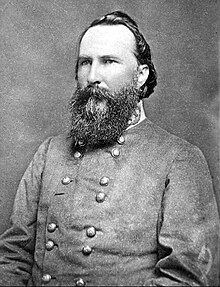James Longstreet
|
Lieutenant general James Longstreet |
|
|---|---|
 |
|
| Nickname(s) | "Old Pete", "Lee's War Horse", "Bull of the Woods", "Pete" |
| Born |
January 8, 1821 Edgefield District, South Carolina, U.S. |
| Died | January 2, 1904 (aged 82) Gainesville, Georgia, U.S. |
| Allegiance |
|
| Service/branch |
|
| Years of service | 1842–1861 1861–1865 |
| Rank |
|
| Unit |
4th U.S. Infantry 8th U.S. Infantry |
| Commands held | Longstreet's Brigade Longstreet's Division First Corps, Army of Northern Virginia Department of East Tennessee |
| Battles/wars |
Mexican-American War American Civil War |
| Other work | Surveyor of Customs in New Orleans U.S. Ambassador to the Ottoman Empire U.S. Commissioner of Railroads U.S. Marshal for Northern Georgia |
| Signature | |
| United States Minister to the Ottoman Empire | |
|
In office 1880–1881 |
|
| Preceded by | Horace Maynard |
| Succeeded by | Lew Wallace |
James Longstreet (January 8, 1821 – January 2, 1904) was one of the foremost Confederate generals of the American Civil War and the principal subordinate to General Robert E. Lee, who called him his "Old War Horse." He served under Lee as a corps commander for many of the famous battles fought by the Army of Northern Virginia in the Eastern Theater, but also with Gen. Braxton Bragg in the Army of Tennessee in the Western Theater. Biographer and historian Jeffry D. Wert wrote that "Longstreet ... was the finest corps commander in the Army of Northern Virginia; in fact, he was arguably the best corps commander in the conflict on either side."
Longstreet's talents as a general made significant contributions to the Confederate victories at Second Bull Run (Second Manassas), Fredericksburg, and Chickamauga, in both offensive and defensive roles. He also performed strongly during the Seven Days Battles, the Battle of Antietam, and until he was seriously wounded, at the Battle of the Wilderness. His performance in semiautonomous command during the Knoxville Campaign resulted in a Confederate defeat. His most controversial service was at the Battle of Gettysburg, where he openly disagreed with General Lee on the tactics to be employed and reluctantly supervised the disastrous infantry assault known as Pickett's Charge.
...
Wikipedia
